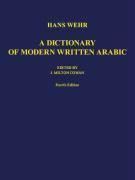6.6 /10 1 Votes
Originally published 1961 | 3.3/5 Barnes & Noble | |||||||||||||||||||||||||||||||||
 | ||||||||||||||||||||||||||||||||||
Similar Deutsches Wörterbuch, Oxford Dictionary of English, Muwattaʼ Imam Malik, Concise Oxford English D, Picture dictionary | ||||||||||||||||||||||||||||||||||
The Dictionary of Modern Written Arabic is an Arabic-English dictionary compiled by Hans Wehr and edited by J Milton Cowan.
Contents
First published in 1961 by Otto Harrassowitz in Wiesbaden, Germany, it was an enlarged and revised English version of Wehr's German Arabisches Wörterbuch für die Schriftsprache der Gegenwart ("Arabic dictionary for the contemporary written language") (1952) and its Supplement (1959). Writing in the 1960s, a critic comments, "Of all the dictionaries of modern written Arabic, the work [in question] ... is the best."
The work is compiled on descriptive principles: only words and expressions that are attested in context are included. "It was chiefly based on combing modern works of Arabic literature for lexical items, rather than culling them from medieval Arabic dictionaries, which was what Lane had done in the nineteenth century".
Collation
The dictionary arranges its entries according to the traditional Arabic root order. Foreign words are listed in straight alphabetical order by the letters of the word. Arabicized loanwords, if they can clearly fit under some root, are entered both ways, often with the root entry giving reference to the alphabetical listing.
Under a given root, lexical data are, whenever they exist, arranged in the following sequence:
Nominal forms then follow according to their length (including those verbal nouns and participles which merit separate listings). This ordering means that forms derived from the same verb stem (i.e. closely related finite verb forms, verbal nouns, and participles) are not always grouped together (as is done in some other Arabic dictionaries). The dictionary does not usually give concrete example forms of finite derived stem verbs, so that the user must refer to the introduction in order to know the pattern associated with each of the stem numbers ("II" through "X") and reconstruct such verb forms based solely on the stem number and the abstract consonantal root.
Transcription and orthography
Transcriptions (for specific details, see Hans Wehr transliteration) are provided for the past tense of the basic verb form, for the vowel of the imperfect tense, and for all nouns and particles, but they are not provided for verb forms of the derived stems, except for any irregular forms, the rare XI to XV stems, and the quadriliteral roots. The morphology of the derived stems II-X is regular and is given in Wehr's "Introduction".
Foreign words are transliterated according to pronunciation, for which Arab students at the University of Münster were consulted. This means that the sounds [eː], [ə], [o], [oː], [ɡ], [v], and [p], which are used in Modern Standard Arabic pronunciation among well-educated and careful speakers, but cannot be easily represented in standard Arabic script (even with full vowel diacritics), can be unambiguously indicated.
As to orthography, word-initial glottal stops or hamza (i.e. the ا vs. أ vs. إ distinction) are not written either in the Arabic of the entries or in the transliteration. For example, اكل (transliterated akala, "to eat", from the root أ ك ل ʼ k l), which has an initial hamzat qaṭʻ, and ابن (ibn "son", from the root ب ن b-n), which does not have an initial hamzat qaṭʻ, are both written without a hamza represented in either the Arabic or the transliteration. In transliteration systems such as DIN 31635, the first would be transliterated as ʼakala, with an apostrophe representing hamza, and the second as ibn, without an apostrophe. Hamzas in the middle and end of words, however, are written, as in مأكل maʼkal "food".
Word-final yā ي (-y or -ī) and alif maqṣūra ى (-ā) are not distinguished in the Arabic: they are both written as ى, without dots (an Egyptian custom). They are, however, distinguished in the transliteration: for example, ثنى ("to double") and ثني ("bending") are both written as ثنى, but the first is transliterated as ṯanā and the second as ṯany.
Editions
The English version of the Wehr dictionary is currently available in two editions. The so-called third printing was printed by Otto Harrassowitz, Wiesbaden in 1961 (reprinted in 1966, 1971) under the title A Dictionary of Modern Written Arabic – Arabic-English as well as by Spoken Language Services, Inc. of Ithaca, NY in 1976. Librairie du Liban in Lebanon printed it since 1980, it is widely available in the Middle East. (ISBN 978-9953-33-673-2) The fourth edition (pictured above), considerably enlarged (1301 pages compared to 1110 in the third printing) and amended, was published in 1979. It is usually available in America as a compact "student" paperback published 1994 by Spoken Language Services, Inc. of Ithaca, NY. (ISBN 0-87950-003-4). There is a more recent German edition available (5th edition).
